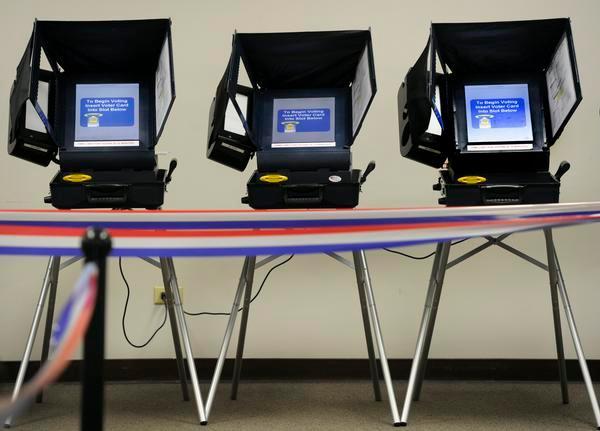Election experts have long warned about the nation’s aging fleet of voting equipment. This week’s elections underscored just how badly upgrades are needed.
Across the country, reports poured in Tuesday amid heavy voter turnout of equipment failing or malfunctioning, triggering frustration among voters and long lines at polling places.
Scanners used to record ballots broke down in New York City. Voting machines stalled or stopped working in Detroit. Electronic poll books used to check in voters failed in Georgia. Machines failed to read ballots in Wake County, North Carolina, as officials blamed humidity and lengthy ballots.
Those problems followed a busy early voting period that revealed other concerns, including machines that altered voters’ choices in Texas, North Carolina and Georgia.
Voting experts had hoped the threat of foreign governments meddling in U.S. elections, raised in 2016 when Russia targeted state election systems, would prompt action to upgrade the machinery that underpins U.S. elections.
But two years before the 2020 presidential election, 41 states are still using machines that were manufactured more than a decade ago and a dozen states are using at least some electronic machines that produce no paper trail, which can be used to settle a disputed outcome. Just three states require the type of rigorous audit backed by cybersecurity experts.
Some of the voting machines in use Tuesday were built before Apple released the first iPhone in 2007, while other equipment has become so obsolete that election workers have been forced to search on eBay for replacement parts.
In some cases, local election offices have no technicians who are trained to repair their machines when something goes wrong. Some even run on Windows operating systems that Microsoft no longer supports.
“You can’t run democracy on the cheap,” said Jenny Flanagan, vice president for state operations with Common Cause. “We have to invest in our democracy to make our elections work.”
Congress sent $380 million to states earlier this year, but that was nowhere near enough to pay for the bulk of the nation’s nearly 10,000 election jurisdictions to upgrade their equipment. Experts with the Brennan Center for Justice have estimated it would take $1 billion or more to make the necessary upgrades.
In Georgia, where numerous problems led to long lines and discouraged voters at polling places Tuesday, the cost to replace its all-electronic machines is estimated at $120 million. The machines have been in use since 2002 and do not produce a paper record that voters can use to verify their selections and election workers can use to audit results.
The election technology in Georgia and the other states using all-electronic machines is so unreliable and vulnerable to hacking that Homeland Security Secretary Kirstjen Nielsen has joined calls for the machines to be replaced. In August, she said she wants “all state and local election officials to make certain that by the 2020 presidential election, every American votes on a verifiable and auditable ballot.”
Voters on Election Day and during early voting in the weeks before reported sporadic problems with election equipment in numerous states, including Florida, Georgia, Massachusetts, Michigan, Missouri, New York, North Carolina, Ohio, Pennsylvania, South Carolina and Virginia, said Kristen Clarke, president of the Lawyers’ Committee for Civil Rights Under Law, which runs the nonpartisan Election Protection voter assistance hotline.
During early voting in Texas, some voters who were casting “straight ticket” ballots for candidates solely of one party found their vote in the nationally watched U.S. Senate race changed to the other party’s candidate. State officials said that can occur when voters complete and submit ballots too quickly, but voting experts said it was wrong to blame voters. The real problem was poorly designed technology that is 16 years old, they said.
“You design it to work regardless of how fast people push buttons,” said University of Iowa computer scientist Douglas Jones, author of “Broken Ballots.”
Jones said Tuesday’s problems were not unusually bad given the state of the technology used. On Election Day, 18 voting locations in Texas opened late because of machine or poll book failures, and some locations still did not have all machines working by mid-afternoon Tuesday.
Officials in 33 states have said they must replace their machines by 2020, according to a Brennan Center for Justice report earlier this year. But so far there has not been a wholesale commitment to paying for the upgrades.
“A big part of this is people who are responsible for making decisions on how the money is being spent think people don’t care,” said Lawrence Norden, a voting systems expert at the Brennan Center. “When you have to make decisions about how to spend money and you are a state legislator, you feel more pressure to spend money on basic services.”
New York Attorney General Barbara Underwood said she was determined to get something done after voters in her state were forced to drop their ballots into emergency boxes or resort to voting by affidavit because so many electronic scanners failed within hours after the polls opened.
New York’s “archaic elections systems aren’t just inconvenient — they also undermine our democratic process,” Underwood tweeted Tuesday.
The malfunctioning equipment turned a polling place in Brooklyn’s Park Slope neighborhood into a “mosh pit,” said Brad Lander, a New York City councilman. By the time he got a chance to vote, all four of the scanners in the precinct were broken.
The clock is ticking to make upgrades, with the presidential election just two years away. Selecting and buying new voting machines can easily take a year and a half or longer, and that’s assuming a state has money to spend.
“It’s not like going into Best Buy, and saying ‘I want 250 of those machines,'” said Vermont Secretary of State Jim Condos.
(AP)











